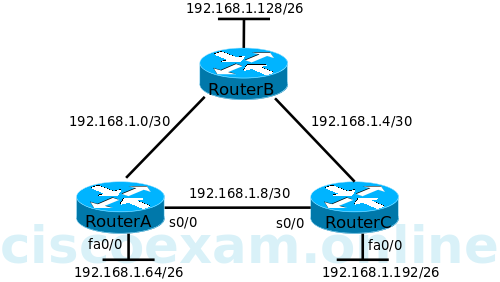
RouterC# show ip route
Codes: L - local, C - connected, S - static, R - RIP, M - mobile, B - BGP
D - EIGRP, EX - EIGRP external, O - OSPF, IA - OSPF inter area
N1 - OSPF NSSA external type 1, N2 - OSPF NSSA external type 2
E1 - OSPF external type 1, E2 - OSPF external type 2
i - IS-IS, su - IS-IS summary, L1 - IS-IS level-1, L2 - IS-IS level-2
ia - IS-IS inter area, * - candidate default, U - per-user static route
o - ODR, P - periodic downloaded static route, H - NHRP, l - LISP
+ - replicated route, % - next hop override
Gateway of last resort is not set
192.168.1.0/24 is variably subnetted, 6 subnets, 2 masks
D 192.168.1.64/26 [90/2892292] via 192.168.1.9, 00:02:23, Serial0/0
D 192.168.1.0/30 [90/2672828] via 192.168.1.9, 00:02:23, Serial0/0
[90/2672828] via 192.168.1.5, 00:02:23, Serial0/1
C 192.168.1.4/30 is directly connected, Serial0/1
C 192.168.1.8/30 is directly connected, Serial0/0
C 192.168.1.192/26 is directly connected, FastEthernet0/0
D 192.168.1.128/26 [90/2892292] via 192.168.1.5, 00:02:23, Serial0/1
Based on the exhibited routing table, how will packets from a host within the 192.168.1.192/26 be forwarded to 192.168.1.1?
| A. |
The router will forward packets from RouterC to RouterB to RouterA. | |
| B. |
The router will forward packets from RouterC to RouterA to RouterB. | |
| C. |
The router will forward packets (from RouterC to RouterB to RouterA) and (from RouterC to RouterA). | |
| D. |
The router will forward packets from RouterC to RouterA. |
From the RouterC routing table we known that network 192.168.1.0/30 is learned via 2 equal-cost paths (192.168.1.9 & 192.168.1.5) - traffic to this network will be load balanced.